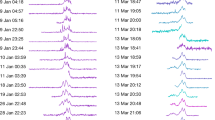Abstract
DURING routine observations of the Crab Nebula by Ariel V, experiment A, the rotation modulation collimator (RMC), discovered a new X-ray source A0535+26. The source was just detectable during the first observation on April 13, and during the 16 d of observation was seen to brighten to nearly twice the Crab's intensity (in the 3–7 keV range). The source varies periodically, with a period of 104 s, and has a very flat spectrum in the 3–7 keV range.
Similar content being viewed by others
References
Eyles, C. J., Skinner, G. K., Willmore, A. P., and Rosenberg, F. D., Nature, 254, 577, (1975).
Ives, J. C., Sanford, P. W., and Bell-Burnell, S. J., Nature, 254, 578 (1975).
Ricketts, M. J., Turner, M. J. L., Page, C. E., and Pounds, K. A., Nature, (1975).
Eyles, C. J., Skinner, G. K., Willmore, A. P., and Rosenberg, F. D., IAU Circ., No. 2274 (1975).
Staubert, R., et al., Astrophys. J. Lett. (in the press).
Author information
Authors and Affiliations
Rights and permissions
About this article
Cite this article
ROSENBERG, F., EYLES, C., SKINNER, G. et al. Observations of a transient X-ray source with a period of 104 s. Nature 256, 628–630 (1975). https://doi.org/10.1038/256628a0
Received:
Accepted:
Issue Date:
DOI: https://doi.org/10.1038/256628a0
- Springer Nature Limited
This article is cited by
-
Exploring the accretion-induced evolution of the spin period and magnetic field strength of Be/X-ray Pulsars
Astrophysics and Space Science (2020)
-
Evolution implications of neutron star magnetic fields: inferred from pulsars and cyclotron lines of HMXBs
Astrophysics and Space Science (2019)
-
High-mass X-ray binaries in the Milky Way
The Astronomy and Astrophysics Review (2015)
-
X-ray emission from Be star/X-ray binaries
Space Science Reviews (1994)
-
A 0535 + 26/HDE 245770: A typical X-ray/Be system
Space Science Reviews (1992)





